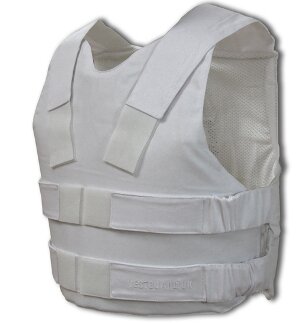A bullet resistant vest should be a part of any comprehensive security plan. A properly designed, manufactured, maintained, and worn vest can make the difference between a bad day and a very bad day.
Most bullet resistant vests are manufactured to standards published by the National Institute of Justice. The current revision of the standard is 0101.06. The standard defines five classifications of bullet resistant vests, based upon their ability to stop various common handgun and rifle rounds. In general, large slow bullets are easier to stop than small fast bullets. The current classifications are IIA, II, IIIA, III, and IV.
| Round | Weight (Grains) | Speed (FPS) | Type |
|---|---|---|---|
| 9mm (FMJ RN) | 124 | 1225 | IIA |
| .40 S&W (FMJ) | 180 | 1155 | IIA |
| 9mm (FMJ RN) | 124 | 1305 | II |
| .357 (JSP) | 158 | 1430 | II |
| .357 SIG (FMJ FN) | 125 | 1470 | IIIA |
| .44 Magnum (SJHP) | 240 | 1430 | IIIA |
| 7.62mm (FMJ) | 147 | 2780 | III |
| .30 (Armor Piercing) | 166 | 2880 | IV |
You can choose a vest type based upon your expected threat. The more protective types are heavier, which means that you may end up wearing them less frequently. The best type of vest is one you will wear.
The specifications above are only for new vests in proper condition. Performance varies depending upon temperature, humidity, equipment wear, and a host of other factors. As your vest wears, its performance will deteriorate. Proper care can extend its usable lifespan, but periodic replacement is necessary.
Design and Fit
The design of every bullet resistant vest is a trade-off between coverage and comfort. The human torso was not designed with bullet resistant vests in mind. The torso needs to move and to breathe. A vest which provides better coverage of the sides and the underarm areas will generally be heavier and less comfortable. A vest which is lighter and more comfortable will generally provide less protection or protection of a smaller area.
Impact
During NIJ testing, each vest is placed upon a form made of modeling clay. The indention which the bullet impact makes in the model clay is known as the backface signature. The NIJ Standard-0101.06 states that no backface signature can exceed 1.97″ (5cm). Think about how hard you would have to hit a piece of modeling clay to create a 2″ indention in the clay. If you get shot while wearing a bullet resistant vest, it can still mess up your day.

